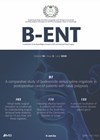
Journal Reviews
MRI scanning patients with cochlear implants and auditory brainstem implants
In the last five to six decades, MRI scanning has gone from physics experiments in Nottingham University through to Nobel prize-winning work by Sir Peter Mansfield and Paul Lauterbur, to a ‘routine’ imaging modality with an estimated 60 million MRI...
How reliable is non-echoplanar diffusion-weighted MRI in picking up postoperative cholesteatoma in children?
Cholesteatoma occurs more often in children than in adults and is more aggressive, often resulting in ossicular erosion and marked conductive loss, amongst other more serious possibilities. Recurrence happens in all three methods used, namely canal wall up, canal wall...
Gadolinium enhanced MRI and the diagnosis of Ménière’s disease
Despite various criteria applied over the years to diagnose Ménière’s disease since the concept of endolymphatic hydrops was first observed in postmortem examinations of patients in 1938, the diagnosis still remains mainly clinical. To visualise endolymphatic hydrops in MRI imaging,...
Relationship between high resolution radiological features of the otic capsuleand audiometric parameters in patients with otscerosis
The audiometric pattern in patients with otosclerosis and outcomes of stapedectomy are variable. Whether this has anything to do with the number of sites affected by otosclerosis in the otic capsule and the disease pattern according to foci location, foci...
REVISIONS acronym for preoperative imaging review in revision endoscopic sinus surgery
The authors have developed an acronym to aid evaluation of preoperative sinus CT imaging in revision endoscopic sinus surgery (RESS). To determine which pertinent aspects of anatomy to include, a systemic review of studies that investigated anatomic contributions to persistent...
How best to follow up a sinonasal cancer?
Sinonasal malignancies are rare tumours and, in the UK, are usually treated in tertiary treatment centres but may well be followed up long term in the patient’s local hospital, so advice on how best to manage these patients is invaluable....
To scan or not to scan?
This comprehensive review article seeks to establish how useful is MRI in the evaluation of patients with a history of smell loss or distortion. Interestingly, while some studies found the imaging unhelpful, one paper described found a 25% rate of...
An advance in imaging for sinonasal tumours?
Benign sinonasal growths are incredibly common, and malignant sinonasal growths thankfully rare. We know that malignant tumours often present late, and the imaging can sometimes be misleading, so the authors here compare using diffusion weighted imaging (DWI), dynamic contrast enhanced...
Reducing nasal changes in SARPE
This paper from Belgium highlights completing a sub-spinal cortectomy of the anterior nasal spine during the procedure of surgically assisted rapid palatal expansion (SARPE) as a means of reducing the alar and columella width as well as the nasolabial angle....
Role of non-echo planar diffusion weighted magnetic resonance imaging in detection of cholesteatoma
Whilst the method of canal wall down and same-session reconstruction is emerging to be more popular, canal wall up procedures are still performed. In either, it is necessary to ensure eradication of cholesteatoma or detect its recurrence. The reliability of...
Management of postoperative cholesteatoma
This prospective longitudinal observational study compared the ability of second-look surgery with that of surveillance using serial non-echo-planar diffusion-weighted imaging to detect residual cholesteatoma after canal wall-up mastoidectomy. A total of 34 patients were included in the study who underwent...
Which scan for children with bilateral sensorineural hearing loss? Keeping the debate going…
There have been years of debate about the appropriate imaging strategy for children with bilateral sensorineural hearing loss. For those children undergoing cochlear implant surgery, CT may provide some assistance to surgical planning, although this is not necessary in children...















